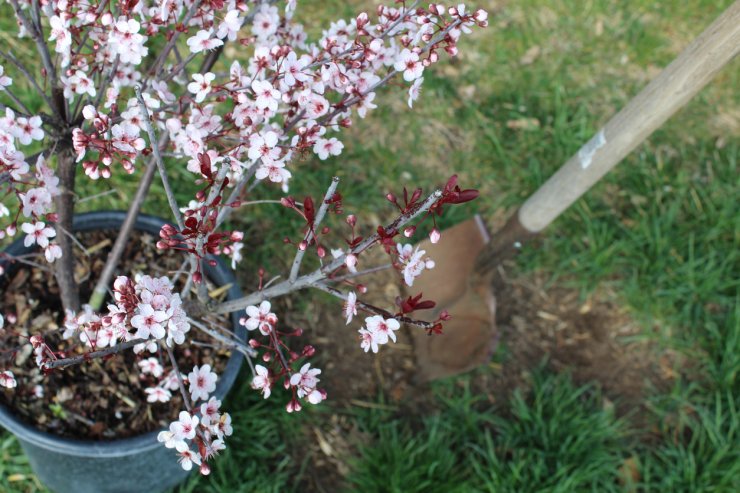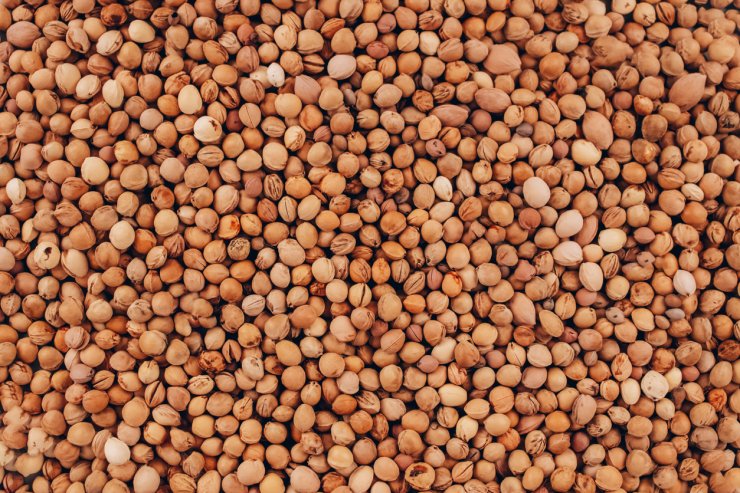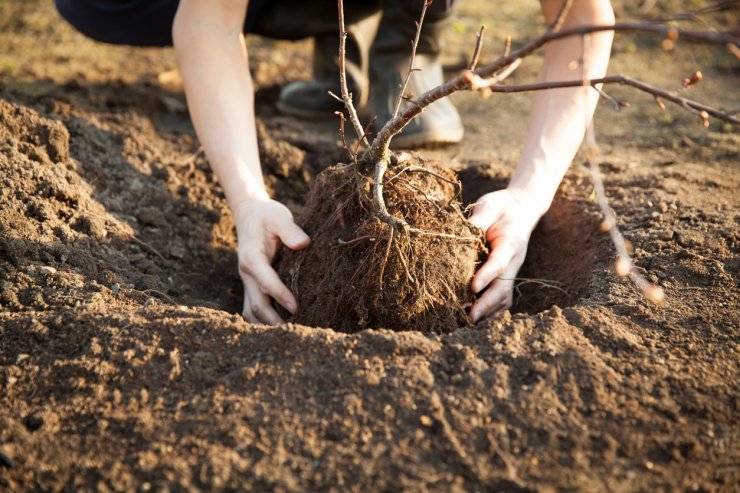
Planting a potted cherry tree
How you grow your cherry trees depends on your patience and preference. Buying live trees will get you to a harvest sooner than planting cherry pits. You can buy cherry trees as either potted plants or bare root plants. As their name suggests, potted plants are grown in pots in greenhouses. They are larger and more expensive than bare root plants and a plant may have new growth on it when you receive it. Bare root plants are grown without soil and are dormant, so there’s just the root on the plant when you receive it.
It all comes down to a matter of taste—and your sense of gardening adventure!
Growing Cherry Trees from Pits

Cherry pits can be used to grow cherries
Growing cherry trees from pits is a long process—up to seven years to fruit—but it can be done, and it’s much cheaper than buying bare-root or potted plants. The fun is in tending your pretty new tree while you wait for it to fruit!
Start by buying some cherries fresh from a local source, not from the supermarket. Those cherries have been refrigerated and probably won’t germinate. And if you get them from a local farm, you’ll know the trees will be suitable for your climate.
After you eat the cherries, save some seeds and put them in a bowl of warm water, allowing them to soak for a few minutes. Then gently clean them to remove remaining bits of fruit pulp.
Spread the seeds out on a paper towel and let them dry for five days. They should be kept in a warm area, like a sunny windowsill. Then put them in a glass jar or plastic container with a tight-fitting lid and stash them in the refrigerator for 10 weeks. This mimics the winter cold they would go through in nature.
Planting Cherry Seeds
After 10 weeks, take the cherry pits out of the refrigerator and let them come to room temperature, about three hours. You can then plant them in a small container with potting soil, planting two or three pits in each container. Put them in a sunny spot and keep them moist, but not wet.
Once you have seedlings about 2 inches tall, thin them so only the tallest remains. Keep them in a sunny spot until spring has arrived and the last danger of frost has passed. Then plant them 20 feet apart, and keep the site protected from trampling by marking it with poles or sticks.
You can also skip the refrigerator process and plant the seeds directly outside in the fall, but you’ll need to plant a few more than you want, because you won’t get as many seeds to sprout. You can plant them wherever they’ll be safe from wind or foot traffic because you’ll transplant them later to a permanent spot (when they’re 10 to 12 inches tall). Put a light layer of mulch around them.
Fertilize your trees each spring until the tree starts to bear fruit, then fertilize only after harvesting each season. Water your cherry trees often. Protect from wildlife that might want to eat the plants by wrapping loosely in burlap in mid- to late autumn, then removing the burlap in early April. Keep doing this for the first two to three years to protect the young bark, which is tasty to many critters.
Growing Cherry Trees from Bare Root Plants

Planting a bare root cherry tree
You’ll wait less for a harvest but spend a little more if you start with a bare root plant. Bare root trees are usually about two years old and can start fruiting in their fourth year (second year for you). Before planting a bare root plant, submerge the roots in cool tap water for four to six hours (24 hours maximum). Dig your hole as noted above, again preserving the topsoil so you can put it into the bottom of the hole when backfilling.
Place the tree into the hole on a small mound of soil with its roots down and spread out. Keep the graft union 2 to 3 inches above the ground. The topmost root should have an inch or two of soil covering it. Fill in the soil around the roots, tamping it down firmly as you go to avoid creating air pockets that could damage the roots.
Once the roots are covered, water thoroughly with about a gallon of water. Let the water soak in and finish filling the hole. Mulch both potted and bare root plants with 4 to 6 inches of shredded bark, keeping the mulch a few inches away from the base of the tree. In the fall, double the mulch layer or add a layer of straw for winter protection.
-
Tip: Keep an eye on the mulch for rodents and other small gnawing creatures that could decide to chew the tree’s bark as a snack.
If you’ve tested your soil and know that you need fertilizer, wait a few weeks after planting to protect sensitive roots. If you plant in the fall, wait until spring to fertilize.
Growing Cherry Trees from Saplings
Potted cherry trees are a popular choice. They’re usually young saplings—less than a year old. Like other cherry trees, you can expect them to fruit around their fourth year. The difference here between bare root plants and potted saplings is the initial amount of TLC they need. Talk to a local nursery for advice for your area and your gardening style.
If you buy potted cherry trees from an online seller—the most common source for cherry trees—remove them carefully from their packages. They should have arrived with damp soil from a watering at the nursery, but they still need another drink upon arrival at your home. Be sure the water reaches all of the roots, all the way to the bottom of the container.
Place your potted trees outside in a sheltered, shady spot. Leave them there for three to four hours and gradually increase the time spent outdoors by one to two hours per day. Bring them back indoors each night.
After two to three days of this process, begin transitioning the trees from their shady spot to one that provides some morning sun. Put them back in the shade in the afternoon. If you can’t be home during the day, try putting them in an area that gets less-intense filtered sunlight instead. Again, bring the trees inside overnight.
Meanwhile, you’ll be watering as needed to keep the roots from drying out—if the soil is dry to the touch, it’s time to water. You can also mist the leaves once in a while, as an indoor environment is dryer than outdoor air.
Keep an eye on the foliage every day. If signs of leaf injury or burn appear, start over with the trees in shade, then move on to morning sunlight again when conditions improve.
After seven to 10 days, your trees will be ready for planting in their permanent home, as long as temperatures are forecasted to stay between 50 and 90 degrees F. It’s best if you can plant on a cloudy day.
Most of the potting soil should remain around the tree’s roots. Gently separate, untangle, and spread out the tree’s roots and place it, soil and all, into a prepared planting hole, deep and wide enough to accommodate the plant’s current root system, while leaving room for the roots to spread out and grow.
When digging, keep the nutrient-rich topsoil separate from the rest of the soil. To loosen the topsoil, mix in aged/rotted manure, garden compost, coir, or peat moss (up to 1/3 concentration).
Plant trees with the graft union—a noticeable bump in the lower trunk—a few inches above the soil level. Holding the trunk to keep it straight, backfill the hole with the topsoil near the roots. Water thoroughly and stake the tree to keep it growing straight.
Have you ever grown cherry trees from pits? How long did it take to get fruit?
Have you tried growing cherries from bare root plants, potted saplings, or both? Which method do you prefer—and why? Please tell us how you get your cherry trees started.


 Previous
Previous

